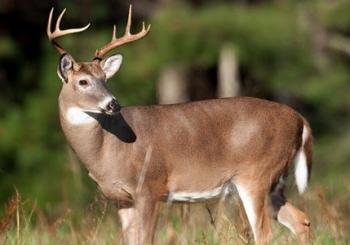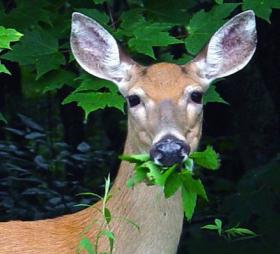Deer Management
The City of Batavia Council formed the Deer Management Plan Committee in November, 2019 which was tasked with exploring ways to reduce property damage to residential landscape and garden plants, deer-human interactions, deer-vehicle accidents and tick-borne diseases such as Lyme disease.
The Deer Committee met several times and worked directly with the Department of Environmental Conservationist (DEC) Wildlife Biologist, Division of Fish and Wildlife, Robin Phenes and City Council representative John Canale to draft a plan to address the deer issues occurring in the City of Batavia.
The plan not only addresses the Deer Committees recommendation on how to reduce the deer population in the City, but provides a streamlined program experience and ensures programmatic compliance, program metric tracking and stakeholder/City Council communication. The Deer Committee has developed a three phased approach with the goal to harvest 60 deer per year with archery only hunting on designated lands within the City of Batavia. The City Council of the City of Batavia approved the Deer Management Plan in September 2020 and the City of Batavia Police Department will administrate the plan. Please see the link provided below is the Deer Management Plan.
DEER MANGEMENT PLAN - Click Here
Additional Information:
This webpage was created to provide information about white-tailed deer (Odocoileus virginianus), strategies for managing the deer population, damage prevention and abatement techniques, public health and safety information, what to do about injured or orphaned deer, and information about the role you can play in managing the City of Batavia’s deer population.
Citizens have varying interests regarding deer. Some are concerned about deer-vehicle accidents or damage to landscaping or crops, while others enjoy hunting, photographing, or watching deer. The numerous, and often conflicting, views on how they should be managed makes the task challenging. The cooperation of landowners and land managers, as well as cooperation among neighbors, is essential to maintaining deer numbers at acceptable levels. A “good neighbor” philosophy is not something that can be mandated, but such a view is essential to successful deer management.
ABOUT THE WHITE-TAILED DEER
According to National Geographic, white-tailed deer, the smallest members of the North American deer family, are found from southern Canada to South America. In the heat of summer they typically inhabit fields and meadows using clumps of broad-leaved and coniferous forests for shade. During the winter they generally keep to forests, preferring coniferous stands that provide shelter from the harsh elements.

Breeding
Adult white-tails have reddish-brown coats in summer which fade to a duller grayish-brown in winter. Male deer, called bucks, are easily recognizable in the summer and fall by their prominent set of antlers, which are grown annually and fall off in the winter. Only the bucks grow antlers, which bear a number of tines, or sharp points. During the mating season, also called the rut, bucks fight over territory by using their antlers in sparring matches.
Female deer, called does, give birth to one to three young at a time, usually in May or June and after a gestation period of seven months. Young deer, called fawns, wear a reddish-brown coat with white spots that helps them blend in with the forest.

Diet and Behavior
White-tailed deer are herbivores, leisurely grazing on most available plant foods. Their stomachs allow them to digest a varied diet, including leaves, twigs, fruits and nuts, grass, corn, alfalfa, and even lichens and other fungi. Occasionally venturing out in the daylight hours, white-tailed deer are primarily nocturnal or crepuscular, browsing mainly at dawn and dusk.
In New York, white-tails, particularly the young, are preyed upon by bobcats, black bears, and coyotes. They use speed and agility to outrun predators, sprinting up to 30 miles per hour and leaping as high as 8-10 feet and as far as 30 feet in a single bound.
Impacts from Deer
White-tailed deer are high-profile animals and among the country’s most popular wildlife species. While most will agree they are beautiful and appreciate their presence, they can have their negative side as well, and when too plentiful, especially in an urban or suburban setting, they can become a nuisance. White-tailed deer are highly adaptable and that adaptability allows them to thrive amongst humans. Furthermore, in many highly-developed areas where hunting does not occur, deer can begin to lose their fear of humans, further exacerbating problems like landscaping damage and vehicle collisions. Deer are also reproductively prolific, and in the absence of hunting their numbers can quickly get out of hand. That said, it is not the number of deer per se that is the problem, but the negative impacts they cause. Any plan to address the negative impacts of deer should take this into account, and progress toward goals should be measured by the reduction of impacts, not necessarily the reduction of the number of deer.
Feeding Deer in the State of New York
It is illegal to feed deer in NY, as well as bear and turkey, whether or not it is intentional or incidental to feeding other wildlife. In other words, even if you are not putting out feed specifically for deer, but you have knowledge that deer are eating it, it is a violation.
The legality of feeding deer in NY is covered in two different places; one by law in the Environmental Conservation Law (ECL) and one in regulation in Title 6 of the Codes, Rules and Regulations of the State of New York.
11-0505 (8) of the ECL (see attachment) prohibits feeding deer within 300 feet of a public roadway.
189.3(b) of Title 6 of the Codes, Rules and Regulations of the State of New York, under Prohibitions covers feeding as well. These regulations outline the particular prohibition making feeding illegal from a chronic waste disease (CWD) standpoint and are a blanket prohibition which covers all deer feeding, regardless of purpose or intent.
Some Tips for White-tailed Deer Coexistence
Do not feed white-tailed deer. Not only is it illegal, feeding increases nuisance behavior and causes deer to congregate in unnaturally high numbers, putting both deer and people at risk
Obey posted speed limits, and drive with caution, especially at dawn and dusk and the months of October through December. Deer are most active in the evening and early morning, and especially during the fall mating season. Deer often travel in groups, so not only be on the lookout for deer crossing roads, but also for other deer about to cross.
Check for ticks after visiting a park or green space. Humans and dogs may contract tick-borne diseases if bitten by an infected tick. Learn more.
Consider planting landscaping that deer find less palatable (see links below).
Repellants, particularly those made from blood meal or putrescent egg solids (rotten eggs) can help with slight to moderate deer browsing, but must be religiously maintained. At high deer densities, or during periods of food scarcity however, repellants will probably not be very effective.
Short of removing the actual animals, a physical barrier of some kind between the deer and what they are eating is the best way to reduce plant damage. Barriers range in size, complexity, visual obtrusiveness and price; the best approach is to start small and work your way up till you find something that works.
Leave fawns alone. It is normal for does to leave their fawns unattended for long periods each day. Taking in fawns that appear abandoned (but almost always aren’t) is illegal and unwarranted.
Call 911 to report an injured deer or an immediate threat to public safety or animal welfare.
Below is a listing of additional resources regarding deer-related issues.
Wildlife Damage Management Fact Sheet Series – White-tailed deer
Managing White-Tailed Deer in Suburban Environments: A Technical Guide
- Deer and Deer Management in New York State
Articles
- http://www.sunset.com/garden/garden-basics/deer-proof-country-garden
- https://www.remodelista.com/posts/the-landscape-designer-is-in-elegant-deer-fencing-hamptons-edition/
Videos

